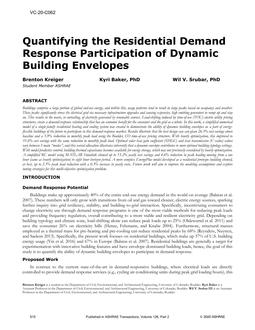
VC-20-C062 — Quantifying the Residential Demand Response Participation of Dynamic Building Envelopes
- Comments Off on VC-20-C062 — Quantifying the Residential Demand Response Participation of Dynamic Building Envelopes
- ASHRAE
Click here to purchase
Buildings comprise a large portion of global end-use energy, and within this, usage patterns tend to result in large peaks based on occupancy and weather. These peaks significantly stress the electrical grid via necessary infrastructure upgrades and causing expensive, high emitting generators to ramp up and stay on. This results in the waste, or curtailing, of electricity generated by renewable sources. Load-shifting induced by time-of-use (TOU) electric utility pricing structures, create a demand-response relationship that has an economic benefit for the consumer and the grid as a whole. In this work, a simplified numerical model of a single-family residential heating and cooling system was created to demonstrate the ability of dynamic building envelopes as a part of energy-flexible buildings of the future to participate in this demand-response market. Results illustrate that the best design case can glean 26.3% cost savings above baseline and a 5.9% reduction in monthly peak load using the Boulder, CO time-of-use pricing structure. With hourly optimization, this improved to 35.6% cost savings with the same reduction in monthly peak load. Optimal solar heat gain coefficient (SHGC) and heat transmission (U-value) values vary between 3 main “modes”, and this varied allocation illustrates inherently that a dynamic envelope contributes to more optimal building typology settings. With model predictive control, building thermal capacitance becomes available for energy storage, which was not previously considered by hourly optimization. A simplified RC model using MATLAB Simulink showed up to 15.2% yearly cost savings and 4.6% reduction in peak loading moving from a one hour (same as hourly optimization) to eight hour horizon period. A more complex EnergyPlus model developed as a residential protoype building showed, at best, up to 2.5% peak load reduction with a 0.3% increase in yearly costs. Future work will aim to improve the modeling assumptions and explore tuning strategies for this multi-objective optimization problem.
Citation: 2020 Virtual Conference Papers
Product Details
- Published:
- 2020
- Number of Pages:
- 9
- Units of Measure:
- Dual
- File Size:
- 1 file , 1.6 MB
- Product Code(s):
- D-VC-20-C062

